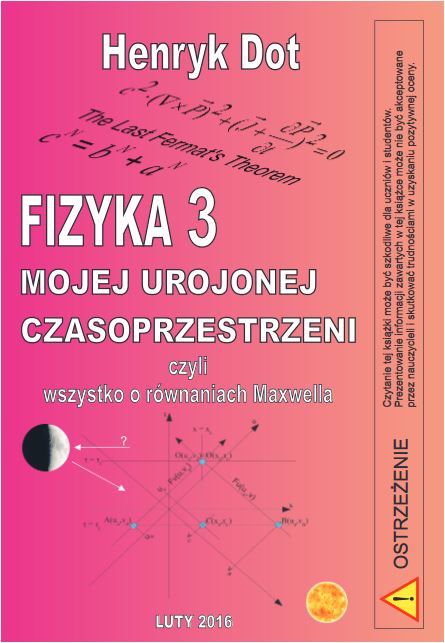★ HenrykDot.com
★
is the online companion to a series of books published by AIUT under the common main title
"Physics of My Imaginary Space-Time" by Henryk Dot.
is the online companion to a series of books published by AIUT under the common main title
"Physics of My Imaginary Space-Time" by Henryk Dot.
Home
Physics 3 - Maxwell
Note from the Author
Table of Contents
What is this book
Historical facts
New aspects
Fully erroneous
Incorrectly interpreted
Physics 3 - Chapter 1
Equations
Complex vectors form
The Most General form
The General Solution
Physics 3 - Chapter 2
Solutions
Initial conditions
Non-homogeneous equation
Solution for three-directions
The four laws
Physics 3 - Supplement
Fermat's proof
Beal's conjecture
Pythagorean triples
Inertial mass
Gravity constans big G
What does the Moon look at?
Physics 3 - Final notes
Final notes
Physics 4 - New book
Entry
Physics 3 - Maxwell
Note from the Author
Table of Contents
What is this book
Historical facts
New aspects
Fully erroneous
Incorrectly interpreted
Physics 3 - Chapter 1
Equations
Complex vectors form
The Most General form
The General Solution
Physics 3 - Chapter 2
Solutions
Initial conditions
Non-homogeneous equation
Solution for three-directions
The four laws
Physics 3 - Supplement
Fermat's proof
Beal's conjecture
Pythagorean triples
Inertial mass
Gravity constans big G
What does the Moon look at?
Physics 3 - Final notes
Final notes
Physics 4 - New book
Entry
Contact
email: henryk.dot(at)aiut.com
"Subject" should begin with
a digit corresponding to the day
of the week., e.g. Sunday=7
"Subject" should begin with
a digit corresponding to the day
of the week., e.g. Sunday=7
Books published by AIUT
are found in libraries according to the list of compulsory copies.
Second Edition of "Fizyka 3"
ISBN 978-83-926856-1-6

can be bought in Warsaw
in the Academic Bookstore
PW Publishing House
Noakowskiego street 18/20
and in Katowice
in the bookstore "Liber"
Bankowa street 11.
(area of Silesian University)
English edition of "Physics"
ISBN 978-83-926856-2-3

is also in libraries
and the distribution method should be asked wydawca@aiut.com.
|
2.2.2. Boundary/Initial conditions problem For second order ordinary differential equations initial conditions are typically stated in this form: | |
| and . | (2.16) |
|
This form can be used as well for certain second order partial differential equations. We have already shown that solution for equation (2.3) is represented by a sum of two functions and along with their initial conditions: | |
| and | (2.17) |
|
and these are also the solutions of the equation. Some degree of experience in solving differential equations expressed like (2.3), makes possible and easy to determine initial conditions in above form. This will allow to avoid solving an equation itself and avoid necessity to determine: . Converting initial conditions from form of (2.16) to form of (2.17) results practically in the solution of equation (2.3). It can be easily noted that reverse conversion is very simple and bijective. So, we have: | |
| , | (2.18) | . | (2.19) |
|
It is more complicated to convert (2.16) to (2.17) since it is necessary to determine
which is “forward” and which is “backward” wave. We can then use the following properties: | |
| since and | (2.20a) |
since , |
(2.20b) |
| then putting these into (2.19) we obtain: | |
| . | (2.21) |
| Comparing this to derivative (2.18-2.20) in respect to variable : | |
| (2.22) | we obtain: |
| (2.23) | |
. |
(2.24) |
|
It can be seen however, that converting initial conditions from (2.16) to (2.17)
is not unambiguous due to remaining undetermined integration constant . We have then, | |
| (2.25a) | |
| , | (2.25b) |
|
where and are integration constants. From (2.18) we determine therefore and finally |
|
| . | (2.26) |
|
Using this conversion of initial conditions and taking into account that: , another possibility of solving the equation (2.3) appears. We have: |
|
| , | (2.27) |
| . | (2.28) |
| After inserting (2.23) into (2.27) and (2.24) into (2.28) we obtain | |
| , | (2.29) |
| . | (2.30) |
| Since the sum of (2.29) and (2.30) forms the expression: | |
| . | (2.31) |
|
This represents D’Alambert solution for equation (2.3), for initial conditions as defined in (2.16).
It is sometimes incorrectly named as “string equation” (e.g. textbook [L2] by Marcinkowska),
since string equation requires boundary conditions in anchored points i.e.
and
, where denotes length of a string.
The string characteristic frequency cannot be determined without these boundary conditions.
Textbook [L3] by Krzyzanski contains relevant paragraph titled correctly “Planewave Equation”. D’Alambert Method”. It can be easily shown using and functions what is the essential difference between planewave and string wave. Simple complementary solution for string wave equation can be presented as well since for string anchored points and boundary conditions apply. , , which means that for function reverses polarity , for function reverses polarity, thus . Both functions must change polarity twice in order for string to be in the same position, which occurs for . The animated figures (Fig. 1a and Fig. 1b) present both solutions of the equation (2.3). Fig. 1a shows a solution for planewave, and Fig.1b for string case. The same initial conditions were applied for both cases: forcing shape function , and holding shape condition i.e. . The wave depicted by black line is the resultant of two component waves, which travel in opposite directions and are depicted by color lines. The red line represents the wave traveling from initial position to the right, while blue line represents the wave traveling from initial position to the left. For planewave case (Fig. 1a) the waves disappear from picture, traveling to infinity. Next waves result from repeating the forcing. For string case (Fig. 1b)) the waves bounce (with opposite sign) from anchored/boundary points, thus they keep their original depicted colors. Both figures present solutions for wave equation (2.3) without any attenuation, thus the waves decay cannot be expected. | |
|
| |
| Fig. 1a PLANEWAVE | |
|
| |
| Fig. 1b STRING | |
© 2020 Henryk Dot -
